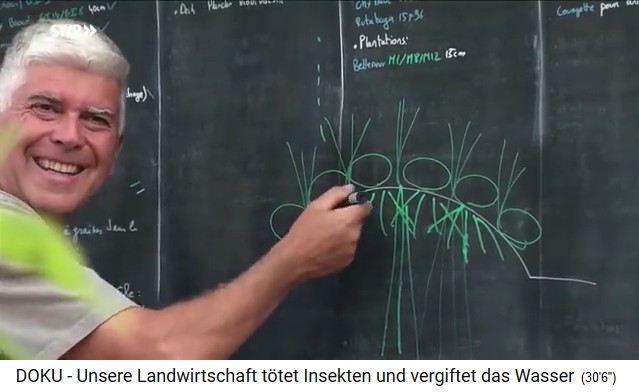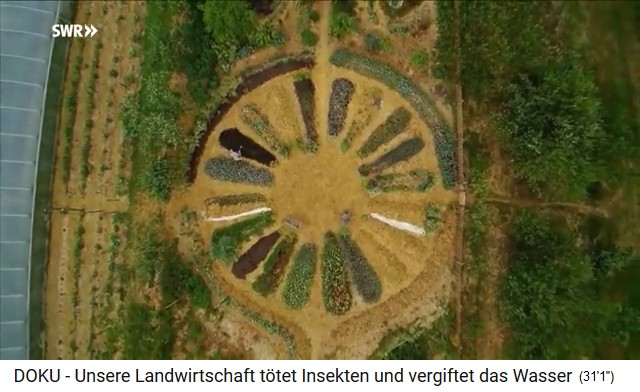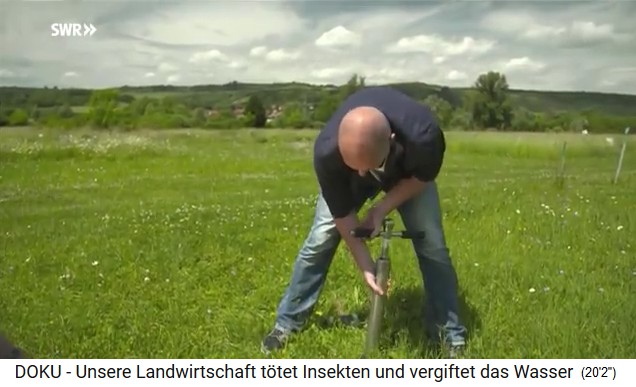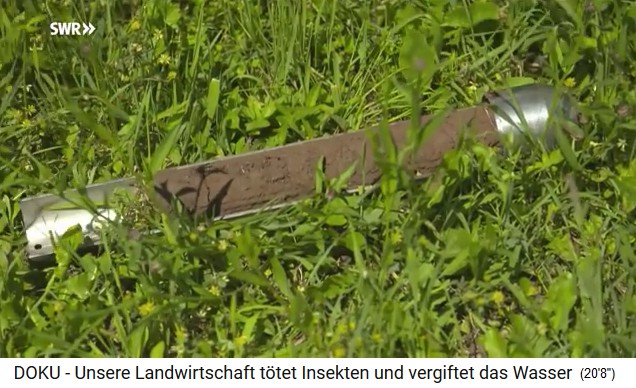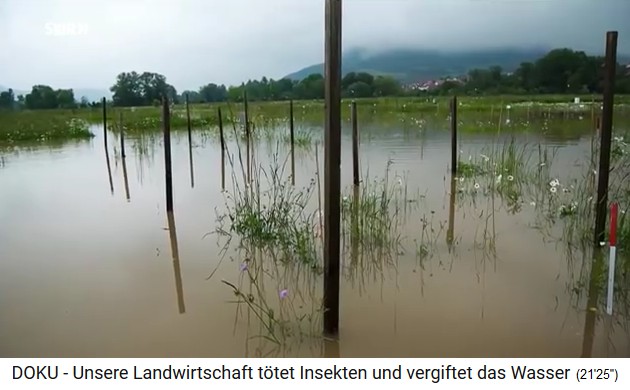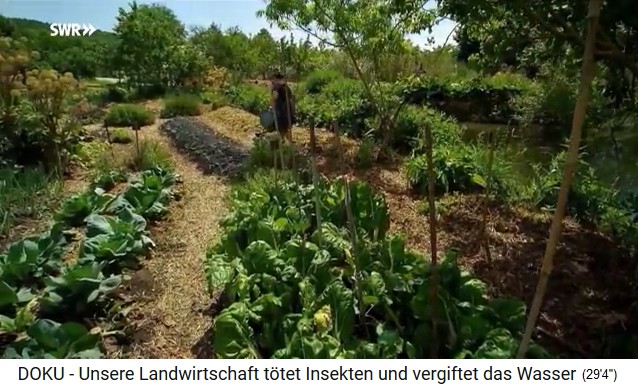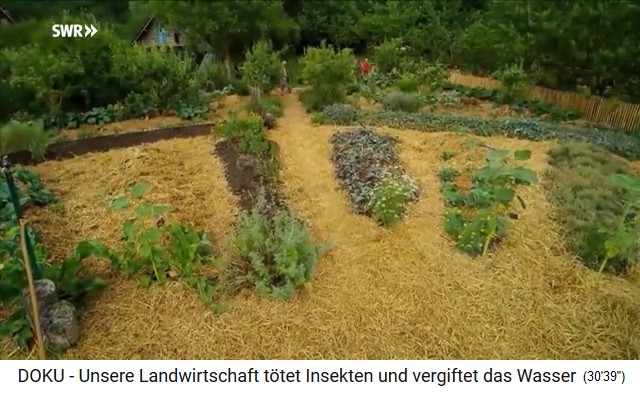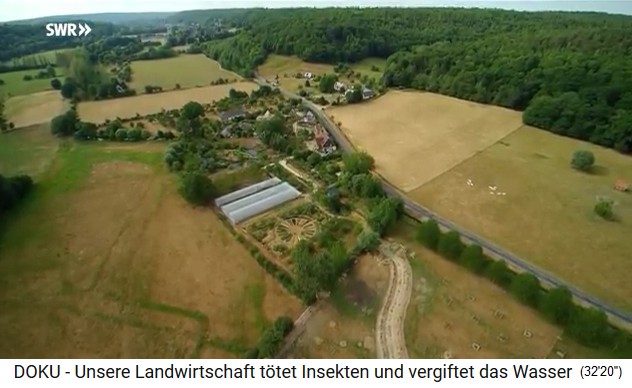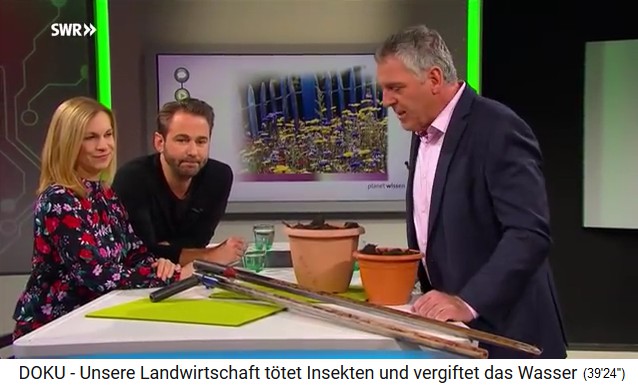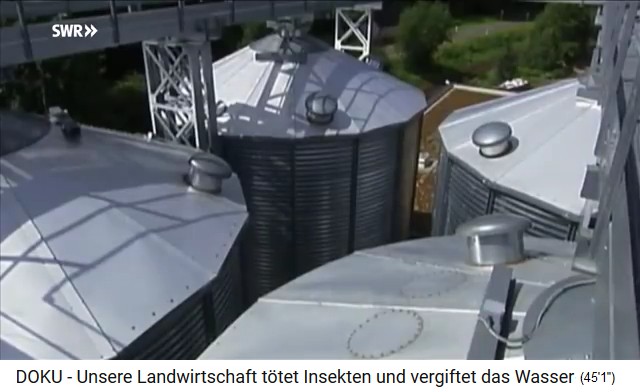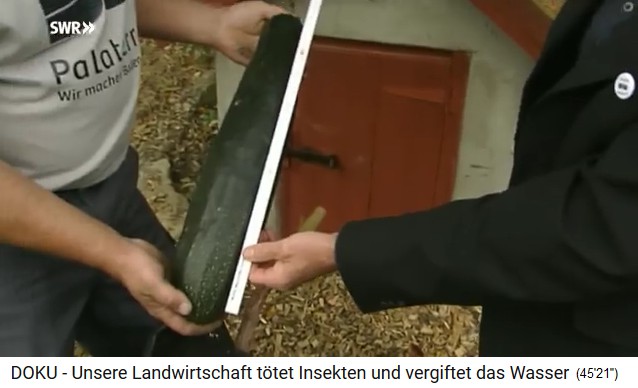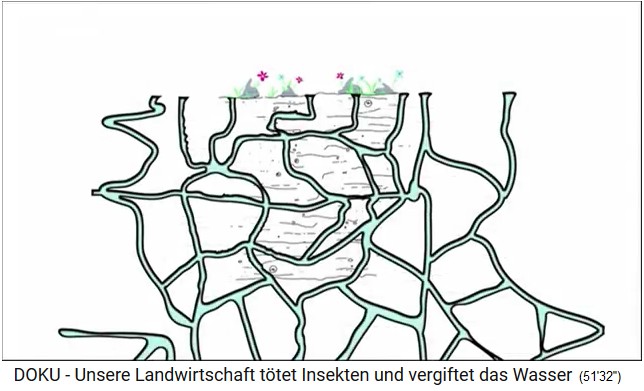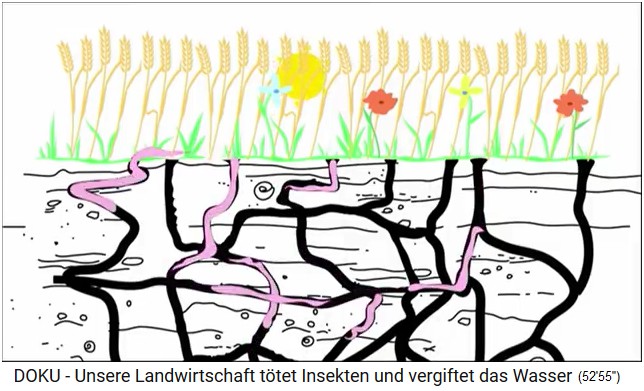

D - ESP -
<< >>
Agriculture WITHOUT pesticides 03 - since April 6, 2018
with bio permaculture
presented by Michael Palomino (2018)Permaculture farm "Bec Hellouin" (Normandy), in a hill bed seedlings are placed 02, general view - Mr. Charles Herve Gruyer explains the hill bed, scheme - the hill beds in the mandala field, aerial photo
| Share: |
Facebook |
|
Twitter
|
|
|
|
========
Content
1. Germany, April 6, 2018: Federal Environment Woman Minister Schulze announces action program for insects+diversity - against glyphosate+monocultures
2. Region of Murcia, June 2, 2018: Criminal chemical agriculture in southern Spain contaminates entire lagoon
Spain: "Serious crimes against the environment": Vegetable supplier of Aldi, Edeka, Lidl and Rewe accused
3a. Soils, June 17, 2018: soil experiments - stronger plants WITHOUT fertilizer - roots, earthworms etc.
Mechanical agriculture DESTROYS EVERYTHING and COSTS MUCH -- The field experiments at Bad Lauchstädt near Halle (Germany) -- Helmholtz Center for Environmental Research: Plants with their roots enrich the soil life -- Helmholtz Center for Environmental Research: The Flood of 2013 and the aftermath: The varied flower meadow is growing stronger than ever before -- The life in the root: Natural fungi and bacteria guarantee a good plant's defense against pests and vermin -- Mineral fertilizer and its effects: Plants resign to fungi and bacteria ("symbionts") and are LESS strong!
3b. Bio-Permaculture, June 17, 2018: Bio-Permaculture farm "Bec Hellouin" in Normandy, beneficial animals, biodiversity, NO machines, NO pesticides, but high crops per m2
Permaculture resigns to mineral fertilizers and agricultural machinery -- Bec Hellouin organic permaculture farm in Normandy: hilly beds, vegetables and tall plants, crops with yield of 50 euros per m2 -- The organic permaculture farm "Bec Hellouin" in Normandy: The plants are more resistant, no costs for pesticides, fertilizers, machines, no artificial irrigation necessary, hardly any risks or failures due to weather or pests or vermin -- Large-scale organic permaculture should work
3c. Gardening, June 17, 2018: Sandy soil - garden soil - compost -- Amazonas Basin with charcoal humus "Terra Preta" -- mulch+manure
Humus recipe from the Amazon basin: Terra Preta "Black earth": charcoal+dung+kitchen waste -- Mulching is important -- Natural plant protection: compost makes plants more resistant - natural fortifiers (e.g. nettles brew) - pest-resistant varieties plant
3d. Earthworm, June 17, 2018: Comic "Rudi the Earthworm": Horticulture with earthworms - book of Charles Darwin "The Earthworm" - mulch and manure
4. Enabavi (India) - July 23, 2018: Organic agriculture - Bayer and Monsanto are NOT needed - with traditional natural agriculture the population lives healthy and WITHOUT cancer
5. August 4, 2018: "USA" with overexploitation in agriculture since the elimination of prairie grass
Agricultural machines WITHOUT SENSES! -- Conclusion Aug.5, 2018: Industrialization with agriculture machines is destroying agriculture!
1. Germany April 6, 2018: Federal Environment Woman Minister Schulze announces action programme for insects - an end to glyphosate, diversity instead of monocultures
Schulze announces quick action program against insect deaths
(original German: Schulze kündigt rasches Aktionsprogramm gegen Insektensterben an)
https://www.extremnews.com/nachrichten/natur-und-umwelt/abb916b1c40bc9b
Translation:
<Thorsten Schmitt
The new Federal Minister for the Environment, Svenja Schulze, wants to take concrete steps to protect insects quickly. "The death of insects is increasing rapidly," the SPD politician told the newspapers of the Funke media group.
========
"In the first 100 days, I want to present key points for an action program on insect protection." Schulze called for all pesticides to be used more cautiously. A fundamental glyphosate phase-out, which must take place in this legislative period, is not enough. At the same time, the Minister spoke out in favour of "a new system of European agricultural support".
A "nature conservation fund at European level" is necessary. For farmers it should be profitable when they plant diversity insteaad of monocultures.
Source: dts news agency>
2. Region of Murcia June 2, 2018: Criminal chemical agriculture in southern Spain contaminates entire lagoon
"Serious crimes against the environment": Vegetable supplier of Aldi, Edeka, Lidl and Rewe accused
(original German: „Schwere Verbrechen gegen die Umwelt“: Gemüselieferant von Aldi, Edeka, Lidl und Rewe beschuldigt)
https://volksbetrugpunktnet.wordpress.com/2018/06/02/schwere-verbrechen-gegen-die-umwelt-gemueselieferant-von-aldi-edeka-lidl-und-rewe-beschuldigt/
Translation:Hier die ganze Sendung von Report Mainz im Video:
<We [in Germany] are accustomed to have fresh fruis and vegetables during the whole year at Aldi, Edeka etc. However, greengrocers use environmentally harmful methods to increase crops. According to the TV program "Report Mainz", this has led to an environmental disaster in Spain.
Strawberries, cucumbers, lettuce or celery - a lot of fruit and vegetables in our supermarkets come from Spain. The Murcia region is even considered Europe's "vegetable garden". And this although it is one of the driest areas of Europe.
[In 2016, criminal farmers desroy the lagoon "Little Sea" ("Mar Menor") by contamination - 80 to 85% of aquatic plants die]
The research team of Report Mainz travelled to Murcia and took a closer look at the conditions on site. The conditions are sometimes frightening: to irrigate the plants, farmers use plastic hoses underground or pump groundwater - sometimes illegally. Even worse: Concealed feed pipes are used to drain wastewater containing high levels of nitrates and other environmental toxins from agriculture into the "Mar Menor" lagoon or the ground.
The research team of Report Mainz travelled to Murcia and took a closer look at the conditions on site. The conditions are sometimes frightening: to irrigate the plants, farmers use plastic hoses underground or pump groundwater - sometimes illegally. Even worse: There are concealed feed pipes used as drainage pipes putting nitrate containing and environmental toxins containing wastewater to the sea lagoon "Mar Menor" or into the ground.
Report Mainz with it's report about Murcia:
https://www.swr.de/report/gemuese-auf-kosten-der-umwelt-setzen-deutsche-einkaeufer-spanische-bauern-unter-druck/22-gemueselieferant-von-rewe-edeka-aldi-sued-und-lidl-wegen-umweltverbrechen-in-spanien-beschuldigt/-/id=233454/did=21660296/mpdid=21739288/nid=233454/12ib27p/index.html
Biggest lagoon of Europe is in danger
The effects are fatal: in 2016 the ecosystem of Mar Menor has overturned - according to Mainz Report, 80 to 85 percent of the aquatic plants in the lagoon have died. Mar Menor is the largest lagoon in Europe and was considered a natural paradise with crystal clear water. Agricultural wastewater has provoked a heavy damage.
One of the companies that used illegal methods to pump and drain water is "G'S España". According to Report Mainz, the company is one of Europe's largest vegetable suppliers and supplies Rewe, Edeka, Lidl and Aldi Süd, among others.
The pricing policy of food companies - [Stawa Murcia with a complaint against the criminal farmers, agricultural companies and those responsible]
Go on reading on utopia.de
However, there is hope that something will happen: the public prosecutor's office in Murcia has reported G´S España and 40 other farmers, agricultural companies and officials. It blames the illegal methods used by farmers for the environmental disaster in the lagoon.
In the report by Report Mainz, a farmer who irrigates fields illegally also has his say. He accuses the pricing policies of the large food chains - including those of German companies: "These are real speculators. They're pirates in fancy suits playing with food for all of Europe. They want to buy everything cheap. The cheaper, the better. This forces many of us to irrigate illegally," says the man in the article.
3. June 17, 2018: Agriculture WITHOUT Pesticides - Bio-Permaculture, beneficial animals, biodiversity, roots, earthworms - video
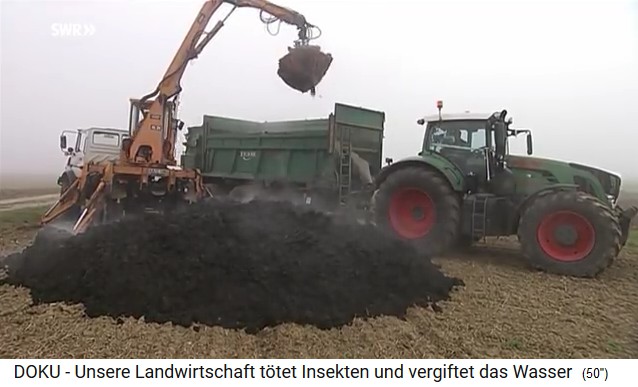
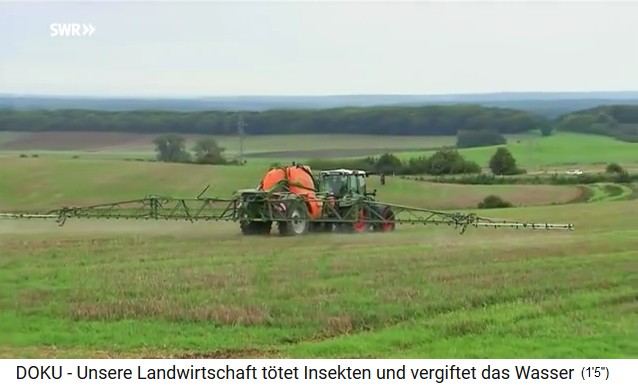
In Germany, sewage sludge with heavy metals as fertilizer is distributed to the fields
In Germany, "pests" and "vermin" are defined and fought with herbicides that also kills the beneficial animals.
Dr. Martin Schädler
Video: DOKU - Our agriculture kills insects and poisons the water (58'55'')
(original German: DOKU - Unsere Landwirtschaft tötet Insekten und vergiftet das Wasser
Video: DOKU - Our agriculture kills insects and poisons the water (58'55'')
https://www.youtube.com/watch?v=CXl71o8MrOQ
Interview partner:
-- Dr. Martin Schädler, soil ecologist at the Helmholtz Centre for Environmental Research (Helmholtz-Zentrum für Umweltforschung - Leipzig and Halle)
-- Prof. Volkmar Wolters, Giessen University (Germany)
-- Werner Ollig, Director of the Garden Academy Rhineland-Palatinate, Vice President of the German Horticultural Society (Deutsche Gartenbaugesellschaft)
The video protocol:
3a. Mechanical agriculture DESTROYS EVERYTHING and COSTS MUCH
Conventional agriculture: fertilizers with nitrate, chemistry in the field by sewage sludge, pesticides kill everything away
On 1/3 of the German fields the limits for nitrate contamination are exceeded (42''). Sewage sludge brings nutrients, but also chemical residues, which then end up back in the food (49''). Pesticides do not only kill animals defined as "pests". Fungicides in particular kill all life in the soil, and more and more weeds are developing resistance to herbicides (1'8''). Insecticides also kill many positive insects (1'21''). "Nearly 75% of insects have disappeared in recent decades, and with them almost as many birds." (1'29'') - Erosion also causes soil destruction of 10 million tons per year worldwide (1'38'').
Dr. Martin Schädler: Conventional agriculture is all about cheap food (1'55''). Sustainability is not planned, and the consequences are now increasingly visible (3'22''). In addition, conventional agriculture reduces the diversity of crops (4'6''). So the market is manipulated on wheat, and thus other cereals are hardly cultivated any more (4'39''). Pesticides and mineral fertilizers have not been around for long yet, before no pesticides or fertilizers was necessary (5'50'').
The field experiments at Bad Lauchstädt near Halle (Germany)
At Bad Lauchstädt near Halle there are field experiments with different soils and conditions (6'50'').

The agricultural experimental field area of Bad Lauchstädt near Halle
Soil suffers from climate change in Germany
Climate change in Germany: The effects will be a higher average temperature and less summer rain, possibly more rain in the other seasons (10'12''). This will also change the soils (11'2''). Microflora and soil animals suffer from summer drought (11'53''). Microflora decreases, the population of soil animals decreases, enzymes in the soil decrease (12'10'').
The function of soils
A healthy soil is a water reservoir, a pollutant filter or also a CO2 reservoir (12'57''). Prof. Wolters from Giessen University takes a sample of the soil in a German forest (13'9'').
Large-scale cultivation with agricultural machinery, heavy fertilization and pesticides destroy the soil structure of microorganisms (13'24''). So much fertile soil is lost and becomes uninhabitable, the desert comes (13'36'').

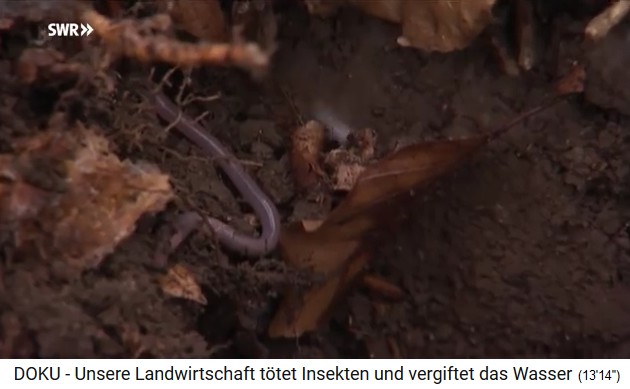
Professor Wolters from the University of Giessen - German forest soil with earthworms - soil animals working in the upper layer of the earth, scheme
The soil is the home to fungi, bacteria, microorganisms, millipedes, woodlice, and then the organic matter is pulled into the soil by earthworms so that plants with roots can settle (15'10''). Mushrooms settle with their roots, bringing the nutrients up into deep into the soil or from the depths up to the plants (15'22'').
Who eats who in the ground? - The food chain
Martin Schädler: Fungi are involved in the formation and degradation of organic matter (16'7''). Fungi are nutrients for underground animals, and fungi collaborate with other plants and are plant nutrient (16'20''). Certain bacteria (nodule bacteria) can absorb the nitrogen from the air and convert it into nitrogen, which is then available to the plants (16'38''). The nodule bacteria receive sugar from the plant and the plant receives nitrogen (17'13''). The microorganisms are eaten by small atopods, small insects, nematodes, hematodes - the "next stage" (17'44'').
The microorganisms produce humus, convert humus into nutrients, earthworms also produce humus (18'19''). The more humus, the more water and nutrients the soil can store (18'31''). So the small creatures are responsible for the looseness of a soil (18'42'').
Helmholtz Center for Environmental Research: Plants with their roots enrich the soil life
An experiment is made with different flower areas on a meadow, sometimes only 1 flower species on a piece of land, sometimes a mixture of 30 flower species etc. The experiment has been running for 15 years (19'30''). Soil biologist Prof. Nico Eisenhauer from the University of Jena: Soil samples have shown that the soil population varies depending on the planting, and that the soil population increases the more different plants are planted on the meadow (19'54''). The more plant diversity is planted on a soil, the more diverse is the soil life with higher soil quality (20'6'').
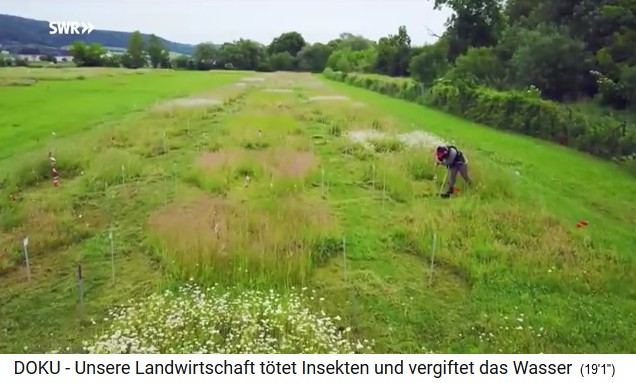

Bad Lauchstädt near Halle, the agricultural experimental meadow - Bad Lauchstädt, Professor Nico Eisenhauer
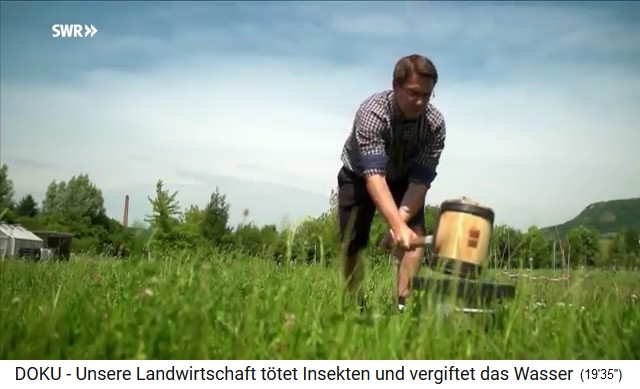
Bad Lauchstädt, Professor Nico Eisenhauer takes a soil sample 01, 02
There are fungi, lichens and microorganisms, up to 1 billion (20'15'') per gram of soil, which supply the plants with nutrients (20'18''). The insects with pollination fertilize the flowering plants and thus ensure the formation of fruits and seeds (20'35''). This is how the "biological meadow cycle" is created: Lice feed on the plant, ladybird larvae and ladybirds eat the lice (20'50''). Dead insects fertilize the soil and thus supply nitrogen for better plant growth (20'58''). Species-rich meadows produce many nutrients (21'3'').
Helmholtz Center for Environmental Research: The Flood of 2013 and the aftermath: The varied flower meadow is growing stronger than ever before
In 2013, the test meadow on the Saale River was flooded for 3 weeks (21'30''). The effects of flooding provoked a new study area (21'36''). The result: the particularly species-rich areas with many different flowers are growing better than ever before and were therefore particularly resistant (21'47''). The areas with little variation or monocultures, on the other hand, recover only very slowly (21'51''). Schädler believes that the highly varied flower meadow has a gigantic advantage for all weather conditions, because there is always a plant species that can cope well with the respective conditions, which then produces new biomass (22'37''). In monocultures, there is only one plant for one weather condition, and floods lead to catastrophe and total failure (22'39''). The use of nutrients is much better in a varied meadow than in a monoculture, because varied plants use nutrients at different depths and from different species (22'52''). After the flooding, the meadow was enriched with new nutrients, and so the varied flower meadow had even more nutrients than before, and therefore after the flooding it grew stronger than ever before (23'1'').
With a variety of flowers in the meadow, the flowers grow better and the soil is also better used and maintained (23'15''). Schädler: The more different plants, the more different soil animals (23'22''), because the roots are also different, which in turn produce more niches for the small animals, and the different roots are forming a broader, material basis in the soil, so that more animal species can live in the soil (23'58''). Schädler: The different roots excrete different substances: Simple ions, complex organic compounds, enzymes, hormones (24'25''), and they communicate with each other, warn each other of being eaten by animals, or plants can call for help if food exists (24'38''), e.g. plants with odors (scents) can attract the threadworm, or can attract other popular microorganisms (symbiants), or by other substances the plant can keep certain microorganisms away (25'7''). So the root is not only there to keep the plant in place or to absorb water, but there is much more connected with a root (25'33'').
The life in the root: Natural fungi and bacteria guarantee a good plant's defense against pests and vermin
Fungi and bacteria ("symbionts") penetrate the roots (25'42''). The roots are supplied with nutrients in exchange for photosynthesis products, i.e. sugar - and therefore the plant grows better overall (25'59''). In addition, the fungi and bacteria ("symbionts") are signal generators. When the plant is attacked (infested), the fungi and bacteria can initiate defense mechanisms (26'18''). A plant with bacteria and fungi ("symbionts") is able to produce active substances against infestation faster than plants without the symbionts (26'23''). Plants without bacteria and without fungi (without "symbionts") defend themselves differently. With symbionts, the defense is performed with more nutrients, which are also present by the symbionts (26'45'').
Mineral fertilizer and its effects: Plants resign to fungi and bacteria ("symbionts") and are LESS strong!
Mr. Schädler: Fertilizing with mineral fertilizer is a direct fertilization of the plant, and the plant will change its behaviour: It repels the bacteria and fungi because the minerals, which normally only come from bacteria and fungi, now are given by humans "from above". In this way the plant can save the release of sugar. Bacteria and fungi that only suck sugar but do not give minerals are blocked by a sugar blockade anyway (27'40'').Thus, an applied mineral fertilizer means that the plant does not work with bacteria and fungi ("symbionts") any more respectively is resigning to bacteria and fungi (27'55'').
3b. Normandy: Organic Permaculture on the farm "Bec Hellouin" - NO machines, NO pesticides, but high crops per m2
Organic Permaculture Farm "Bec Hellouin" in Normandy: Permaculture resigns to mineral fertilizers and agricultural machinery
In France, the most successful organic farm "Bec Hellouin" is operating in Normandy since 2003, with permaculture, that means without fertilizer and without petroleum products (28'13''). The art is to "harvest much from little land" (28'37''). It is 1400m2 of land on a creek, where 70 kinds of vegetables are cultivated (29'7''). The different plants attract different insects, beneficials and pests (vermin) and this is well balanced, rare birds come back, wild bumblebees are the pollinators, not bees (29'14''). Permaculture orders the renunciation of artificial fertilizers and agricultural machinery (29'34''). The beds are hilly and cannot be machined (29'40'').
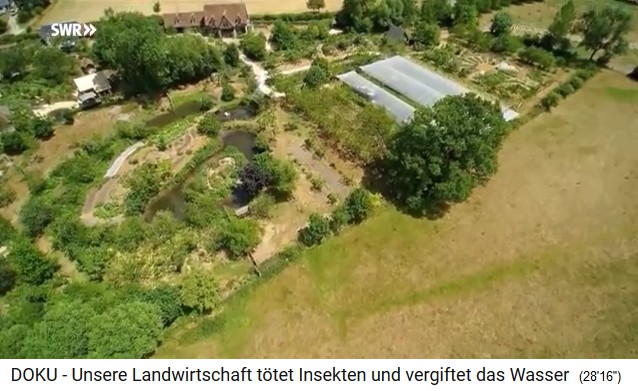
The permaculture farm "Bec Hellouin" in Normandy

Charles Herve Gruyer has installed the permaculture farm "Bec Hellouin" in Normandy - permaculture farm "Bec Hellouin" in Normandy, the cultivation takes place on mini fields and any variety is planted
Bec Hellouin organic permaculture farm in Normandy: hilly beds, vegetables and tall plants, crops with yield of 50 euros per m2
Charles Hervé-Gruyer from the Bec Hellouin organic farm explains: "You make a hilly bed that is densely planted, vegetables alternately with tall plants, "thus creating a plant community" (29'50''). The soil is full of roots, each soil gets its "microclimate" (29'59'').

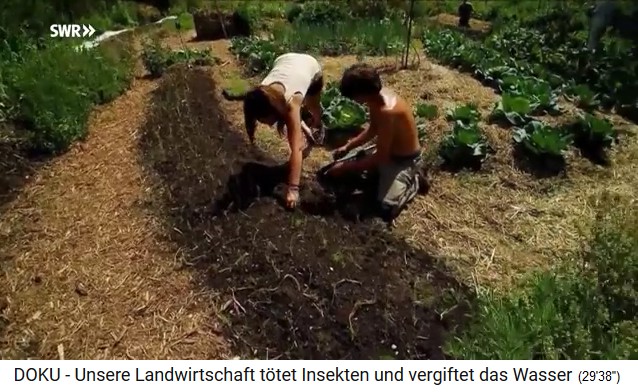
Permaculture farm "Bec Hellouin" (Normandy), seedlings are planted on a hill bed 01, 02
Permaculture farm "Bec Hellouin" (Normandy), Charles Herve Gruyer explains the hill bed, scheme
The high root density prevents erosion during rain (30'3''). Such a soil is full of earthworms, bacteria, fungi (30'8''). With each harvest the soil becomes more and more fertile [because the roots remain in the soil and are converting into new, excellent humus] (30'17''). One principle of varied perma agriculture is to install the hilly beds in form of a mandala, the "mandala field" from Asia (30'27''). All beds should be optimally aligned to the sun (30'35''). The result is a yield of 50 euros per m2 (30'48''). That is almost ten times the yield of a conventional tractor mechanical machinery farm with pesticides (30'56'').

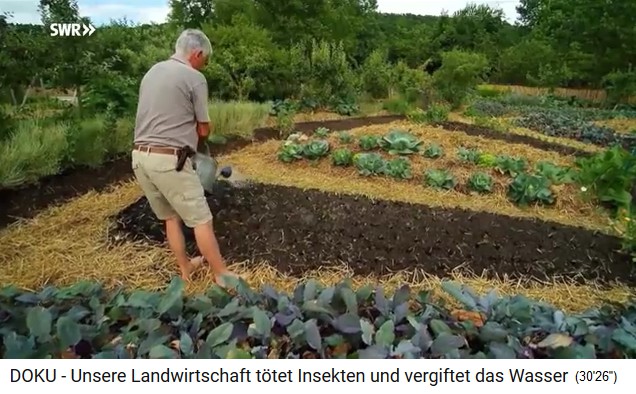
Permaculture farm "Bec Hellouin", a hill bed with cabbage - Permaculture farm "Bec Hellouin", hill beds in the mandala field 01, 02
Permaculture farm "Bec Hellouin", hill beds in the mandala field, aerial photo
The organic permaculture farm "Bec Hellouin" in Normandy: The plants are more resistant, no costs for pesticides, fertilizers, machines, no artificial irrigation necessary, hardly any risks or failures due to weather or pests or vermin
The Ministry of Agriculture in Paris confirms that on the organic farm in Normandy 3 to 4 times more vegetables per m2 grow than in a conventional bed - and all at no cost for pesticides or machines (31'20''). The Bec Hellouin organic permaculture farm is extremely efficient because there are hardly any operating costs without pesticides, machines, artificial fertilizers and artificial irrigation. Just come people have to be employed for the hand work, that's all (31'39''). In addition, the beds are enriched with the farm's own mulch and protected (31'46'').
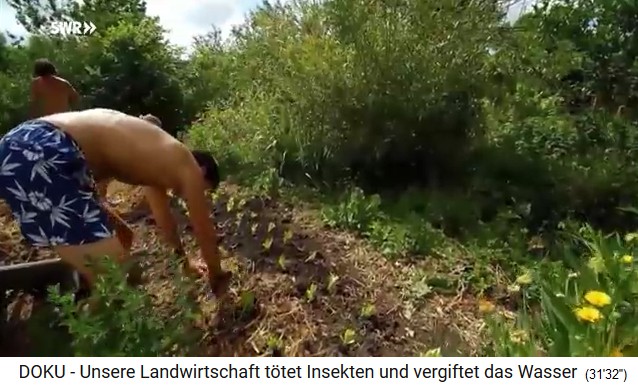
Permaculture farm "Bec Hellouin": mulch is laid on the hill beds - the organic permaculture farm "Bec Hellouin" in Normandy, aerial photo
François Léger of the Institut National de la Recherche Agronomique (Paris National Agricultural Research Institute): "If you are clever and take into account and exploit all the factors of nature, you produce the same quantity, but with lower production costs because the plants are more resistant (32'2''), and the risks and losses due to weather and pests and vermins are also smaller (32'6''). The bio-permaculture farm works much more cost-effectively (32'11'').

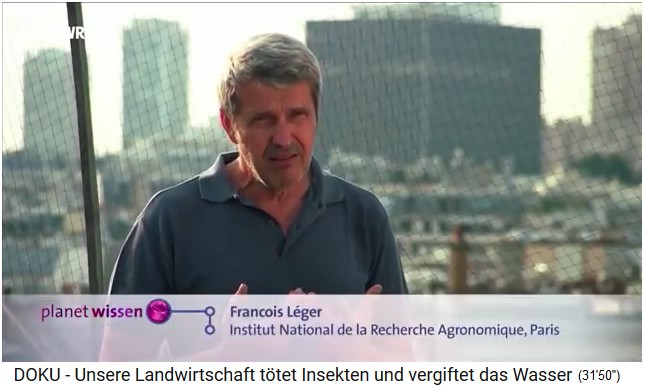
The Agricultural Research Institute in Paris, the experimental plants on the roof terrace -- François Léger from the Agricultural Research Institute Paris
The question is whether this bio-permaculture agriculture can also be applied to large areas (32'24'').
In addition, organic permaculture promotes biodiversity (32'27'').
Large-scale organic permaculture should work
Mr. Martin Schädler: The principles should also be applicable on a large scale (32'35''). Closed circuits and mixed culture are all possible, even self-regulation with pest beneficials (predator-prey systems) pollination should actually run even better on a large scale than on a small scale (32'50''). How it affects the economy has to be tested, because machines on large areas are more efficient (33'0''). In general, the farmer must have an intelligent, combinatorial bain for permaculture, this is is not as stubborn as the rules of conventional agriculture (33'6''). So the farmers should try it, first on a small scale, and then on the large field (33'14'').
3c. Gardening (horticulture) with Werner Ollig
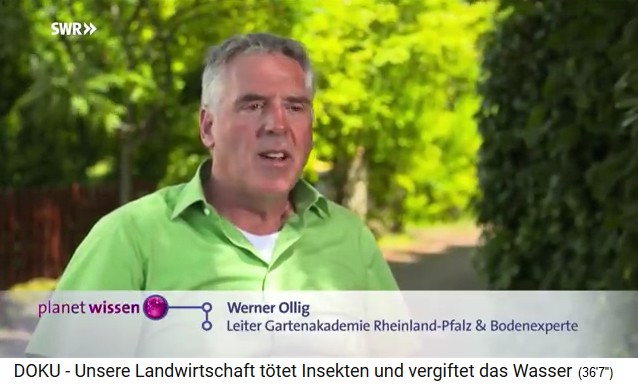
Werner Ollig, portrait
The soil sample in the garden - sowing large plants whose roots loosen the soil
Werner Ollig, head of the Garden Academy of Rhineland-Palatinate, vice president of the German Gardening Society (Deutsche Gartenbaugesellschaft): Homeowners have often turned their front gardens into parking lots, completely built up, or filled them with gravel with a foil in the ground so that no weeds can come from below (34'13''). This means that every homeowner with a well-kept front garden can contribute to more insects and birds (34'55''). Horticulture tips: In soil where nothing grows, people have no idea what a soil is. A soil sample in the laboratory provides clarification, should be taken every 3 to 5 years (36'51''). If there is no humus in the soil, nothing grows either (37'14''). Lack of nutrients is not the cause, but the lack of humus, in the garden it should be 4 to 6% (37'57''). In addition, the "green fertilizer" is missing: seed seeds of clover, rape, sunflower or facilia (38'9''). These plants grow with the plant, can be cut off after flowering and put on as gauze (38'13''). This is how humus is built up, nutrients are enriched, the roots loosen up the soil and weeds are displaced (38'22''). Soil samples include pH, phosphorus, potassium and magnesium, and the content of humus (39'2'').

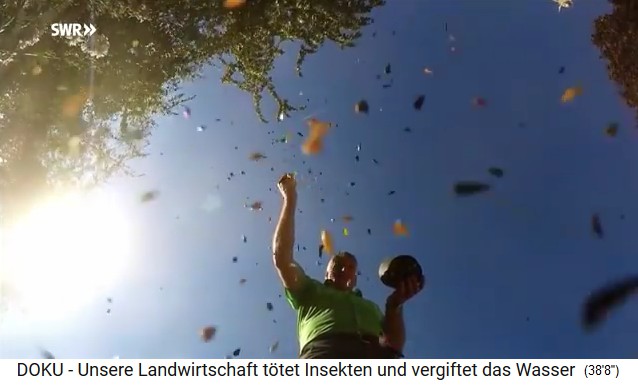
Werner Ollig complains: In Germany many front gardens become parking lots - Werner Ollig with green seeds - Werner Ollig presents two soil samples: sandy soil and garden soil
Sandy soil - garden soil - compost
Sandy soil is light brown and reddish in the depth, if you grind it, sand comes out which is sanding (39'51''). The humus content of sandy soil is low at 1.5% (40'3''). Dark brown soil contains a lot of humus, 5 to 6% of humus (40'27''). Compost fertilization is usually 3 litres of compost per year (41'31''), for sandy soils 5 litres of compost per year (41'40''). Apply and incorporate the compost so that the billions of microorganisms in the soil can work and improve it (41'52''). Compost is produced by leaves, branches, vegetables, vegetable leaves, potato peels, etc. (42'24''). Compost also stores CO2 (43'22'').
Gardening in Amazonas Basin with charcoal humus "Terra Preta"
Amazonas jungle with rivers (Amazonas River?)
Humus recipe from the Amazon basin: Terra Preta "Black earth": charcoal+dung+kitchen waste
Natives of the Amazon have a special humus recipe, "black earth" (Portuguese: "Terra Preta"). The mixture consists of charcoal, manure (fertilizer) and kitchen waste (44'19''). Some of the layers were applied meters thick (44'26''). The charcoal in the "black earth" stores a lot of water and nutrients (44'30''). The "black earth" is probably the most fertile soil in the world (44'38'').

Amazon Basin: Compost soil with charcoal "Terra Preta" (Portuguese: black earth) - The humus layer with Terra Preta is partly meters thick.
In Germany the "black soil" is analysed and imitated: there is charcoal, green waste and fermentation residues from a biogas plant, the mass is enriched with bacteria and fungi and stored for 2 weeks, then spread on beds (45'8''). Vegetables become huge and taste great, the plants grow up to 4 times as big as normal (45'23''). Well, this is a super fertilizer (45'30''), is a very good substitute for peat (46'6'').
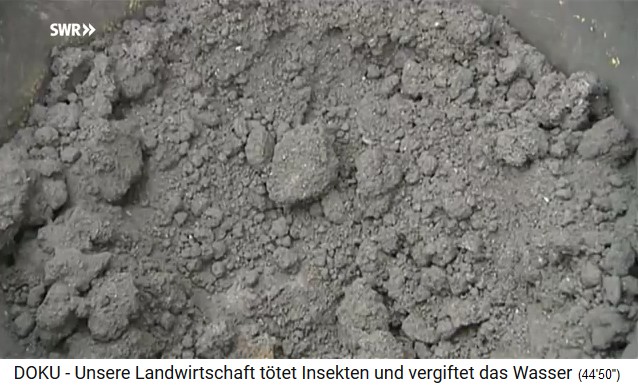
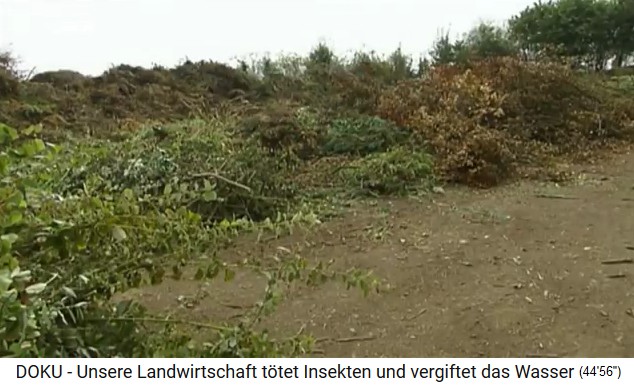
Investigation of Terra Preta at Henstbacher Hof: Components are charcoal+green waste+residues from a biogas plant
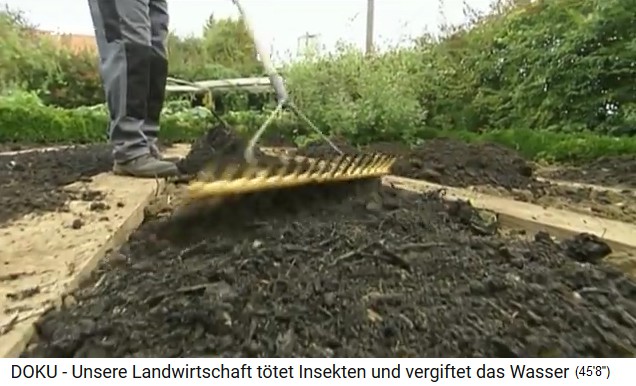
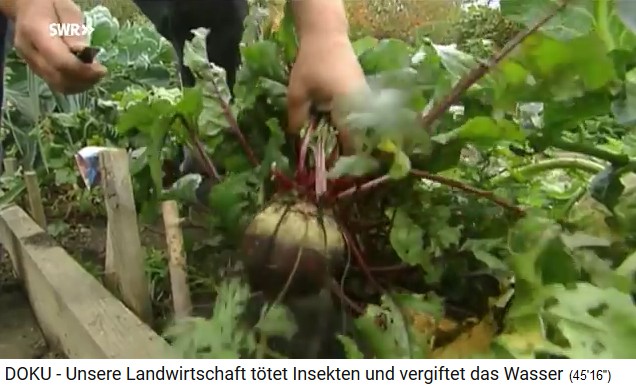
Hengstbacher Hof: The new Terra Preta is laid out for 2 weeks - and then giant vegetables beetroot and courgettes are growing
Mulching is important

Werner Ollig, portrait
Mulching is important, saves 3 to 5x watering (46'41''). The mulch prevents water evaporation, prevents drying out, you can save a lot of water, and the mulch is again consisting of nutrients that are fed to the soil, one of the mulch possibilities is e.g. cut lawn (46'57''). Putting the cut lawn on the lawn, this saves the disposal of the lawn cuttings AND the watering (47'39''). You can also leave the lawn cuttings on the lawn, so the soil becomes more fertile and hardly dries out (48'9'').
Natural plant protection: compost makes plants more resistant - natural fortifiers (e.g. nettles brew) - pest-resistant varieties plant
Compost strengthens the plants and makes them less susceptible. Natural strengthening agents provide additional protection. Furthermore, pest-resistant varieties can be cultivated. Then the gardening goes completely WITHOUT pesticides (48'47''). Special useful plants are e.g. the nettle, where many useful animals live (49'10''). With nettles you can make a nettle water, this is a great fertilizer, strengthens the plants with a lot of silicon (49'19''). In this way one can produce it's own plant strengthening agent (49'27'').
Horticulture without wood protection preservatives
Wood preservative should never come into contact with the ground. Wood preservatives can be avoided with resistant wood species, e.g. chestnut [or oak]. (50'38'')
3d. Comic "Rudi the Earthworm"
Horticulture with earthworms - book of Charles Darwin "The Earthworm"

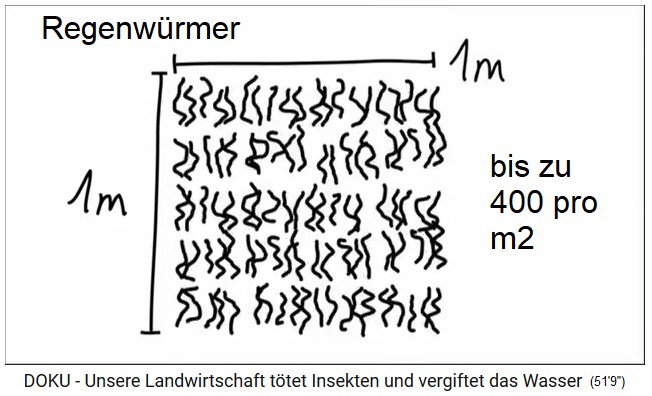
Comic "Rudi Earthworm" - Comic: On 1 m2 there are up to 400 earthworms - Comic: Earthworms pull leaves down into the ground
Earthworms: In healthy soil there are up to 400 earthworms per m2 (51'8''). Earthworms dig tunnels, eat plant remains, and the excrements are on the earth's surface and are new humus (51'24''). Acid soil is neutralized, the tunnels loosen up the soil and aerate it (51'32''). The value of earthworms was not recognized until 1881 by Charles Darwin with the book "The Earthworm". Earthworms are tunnel builders, dig several meters deep so that soils can absorb more rainwater (52'25''). When it rains, the earthworms then flee upwards, otherwise they would suffocate when the tunnels are full (52'32''). Earthworms cannot be divided, only the front part lives on (52'51''). Earthworms live to be over 8 years old (53'5''). Ollig: Earthworms feel most at home under grass floor, and therefore under grass floor is the highest density of earthworms (53'25'').
Gardening work as an antidepressant
New natural medicine with earth soil: antidepressant effect in horticulture
When humans or farmers are digging in the soil in the garden or on a field, this provokes the uptake of minerals and certain types of bacteria, which are ingested by the skin or through breathing, and the effect is like certain antidepressants, without or only with positive side effects ( 54'28''). So if you work in the garden with bare hands, this has a strong effect, but working in the garden with rubber gloves permits the antidepressive effect only through breathing (54'43''). Gardening is like a mineral antidepressant treatment (55'3'').
The balcony garden
Compost is also for balcony pots (55'43''). On a balcony one can let grow kitchen herbs, mint, strawberries, small currants, mini apple trees, like a sweet garden (56'25''). Earthworms are fed with organic material [leaves, kitchen garbage] (56'50''). Insects and birds come for a visit to blooming gardens (56'53'').
Horticulture: mulch, mixed cultivation, green fertilizing (manuring)
So, there will be much achieved when mulching, mixed cultivation and green fertilizing (manuring) are applied (57'52'').
========
4. Enabavi (India) - July 23, 2018: Organic agriculture - Bayer and Monsanto are NOT needed - with traditional natural agriculture the population lives healthy and WITHOUT cancer
India sets an example - organic farming instead of BayerMonsanto! - INDIA: Organic farming instead of Bayer Monsanto!
(original German: Indien macht es vor – Ökologischer Landbau statt BayerMonsanto! – INDIA: Organic farming instead of Bayer Monsanto!)
https://netzfrauen.org/2018/07/23/organic-2/
Telangana village agriculture…. Village women’s singing songTranslation:How This Telangana Village Banished Poverty And Farmer Suicides Through Organic Farming
<One should give these farmers in India the world food price and not Monsanto and Co, because we show you in this article that there is another way. In March 2014, the Intergovernmental Panel on Climate Change (IPCC) warned that the world's food supply was at risk. And it is no joke, or as they say today: It's NOT FAKENEWS, that it was Monsanto and Syngenta that received the World Food Prize in 2013. And in 2014, a resident of India just got the prize for genetically modified wheat. It should be known that hundreds of thousands took their lives in India after the so-called "Green Revolution" due to enslavement. Poverty and suicides of farmers were and are the result of genetically manipulated seeds [with the Monsanto tactic to destroy the farmers], with all the dangerous pesticides in tow, such as glyphosate.
There is a village in India which has defeated the poverty and suicides of farmers through organic farming. Farmers' debts and suicides were widespread, but that is over now. The change to biodynamic cultivation made the poor fields of Enabavi green again.
Link: Suicide of farmers in India because of criminal Monsanto GMO-tactics against farmers (German):
https://netzfrauen.org/2013/09/02/indien-samen-todes-und-versklavung-alternativ-eigenes-bio-saatgut-statt-saatgut-abhaengigkeit-biopiraterie-nein-danke/
[India: Bayer and Monsanto with genetic plants brought death and ruin in India: harvests -50%, groundwater disappeared, biodiversity is reduced]
When we talk about Indian agriculture, we remember the many suicides committed by farmers after the Green Revolution entered India. We have often reported on the Green Revolution. It is not environmentally friendly and therefore not sustainable. Harvest profits are half of before. More fertilizer no longer guarantees higher yields. Groundwater resources are reduced and biodiversity has suffered greatly. Nowhere is this clearer than in India.
In 2014, the World Food Prize was also awarded to genetic engineering, as it was all the years before and in the future; this time it was genetically modified wheat. The 2014 World Food Prize went to plant researcher Sanjaya Rajaram. He was born in 1943 in Varanasi, India. Connections: Bill Gates, Norman Borlaug, CIMMYT and Dr. Sanjaya Rajaram can be found here: USA World Food Prize 2014 with poisons and genes!
It was just a resident of India who plunged the small farmers in India into poverty. Rajaram was creating new genetic modified plants at CIMMYT (International Corn and Wheat Research Centre), in this case wheat for bread, and he needed three decades for it. These genetic modified wheat seeds are cultivated on around 58 million hectares worldwide and on around 8 million hectares in India. It was hoped that the use of several genes would provide long-term resistance to rust, one of the most dangerous wheat diseases worldwide. But other diseases should also be prevented by genetic manipulation.
[Genetic seed is more expensive but yields less]
Today we know that nature is returning: more and more farmers are turning leaving GMOs - more and more doubts are growing behind the Monsanto deal about the GMO revolution. Farmers in the USA are also reconsidering the use of biotech seeds because their high prices are becoming increasingly difficult to understand in view of the meager profits of current agriculture. But the matter is not only about wheat or corn, but also cotton.
Article: Doubts about meager profits but high costs for destructive GMO products (German): https://netzfrauen.org/2016/11/09/gmo-zweifel/
[Burkina Faso throws out genetically modified cotton]
Did you know that 85 percent of all cotton planted worldwide is genetically modified? No other crop is treated as strongly with pesticides, fertilizers, growth substances and defoliants as cotton. Due to the poor yields, Burkina Faso has stopped genetically modified cotton: Fuck off Monsanto's genetically modified cotton - back to nature!
Also in India corporations such as Monsanto promised that the Green Revolution would bring a technological breakthrough. However, the success of the high-yielding varieties, which had to be treated with chemical fertilizers and pesticides, was short-lived. But the suffering continues to this day.
Agribusiness of the pharma mafia is against the farmers
[India's cotton regions suffer from cancer due to pesticides - land degradation and devastation (desertification)]
According to food.ndtv.com, the Malwa region in Punjab was called India's "cancer belt". The unusually high incidence of cancer has been linked to the excessive use of pesticides by cotton farmers. In its fifth national report on desertification, land degradation and drought, published in 2015, the government acknowledged this. Land degradation is a major environmental problem for the country. It appears that one third of India's land is degraded, while 25 percent of its land is exposed to desertification, which has affected the productivity and food security of millions of people across the country.
Links:
Organic farming in India is a success story: https://food.ndtv.com/opinions/organic-farming-in-india-a-success-story-1290265
Climate change may increase nutrition disorders: http://food.ndtv.com/health/ignoring-climate-change-may-increase-nutrition-disorders-746425
Experts say that lack of food safety will kill 2,2 million every year:
http://food.ndtv.com/food-drinks/lack-of-food-safety-killing-2-2-million-every-year-experts-752560
"The continuous use of chemical fertilizers and pesticides robs plants of their starch and makes them more susceptible to disease. We let nature work and cultivate the soil for constant growth. The results can be stagnant at first, but remember that you will be harvesting for a long time," said the makers of organic farming in this affected region.
Link: Simple tricks to remove pesticides from fruits and vegetables:
http://food.ndtv.com/food-drinks/simple-tricks-to-remove-pesticides-from-fruits-and-vegetables-696039
"We want to get farmers to adopt such practices and return to the basics. This will help reduce the threat of pollution from the purchase of high-priced chemicals while increasing the earth's vitality."
The following story also shows how to defeat poverty and suicides through organic farming.
The village of Enabavi in Federal State of Telangana (India) wins it's health back with organic biologic agriculture with Mother Earth
[Enabavi in Telangana: Organic farming restores farmers' health - soils are back to normal - normal yields]
For example, this village in Telangana banned poverty and suicides of farmers through organic farming. Farmers' debts and suicides were common, but that's over. Organic farming means that farmers no longer have any health problems!
By the change to organic farming, a village [Enabavi] in Telangana has transformed its barren soils into lush green farms, and there are no suicides nor health problems any more, and the crops and yields are increasing.
See the example of the village of Enabavi in India:
The village of Enabavi in Telangana (India) saved it's existence from criminal Monsanto to original agriculture with Mother Earth
How This Telangana Village [Enabavi] Banished Poverty And Farmer Suicides Through Organic Farming - Indebtedness and farmer suicides were common, but not anymore
http://www.huffingtonpost.in/village-square/how-this-telangana-village-banished-poverty-and-farmer-suicides-through-organic-farming_a_23316501/
by Chithra Ajith, Warangal, Telangana
Chitra Ajith is a journalist in Kozkikode, Kerala. This article was published first in VillageSquare.in, a platform of public interest with rural topics of India.
Photo text: Practicing organic farming, farmers no longer have health issues.
The article:
<Switching to organic farming, a Telengana village has turned its arid lands into lush green farms, overcoming the scourge of farmer suicides and health problems in the process, and increasing household earnings
By Chithra Ajith*, Warangal, Telengana
There was a time when Enabavi was just another impoverished village in the arid plains of Warangal in Telengana, full of frustrated farmers, some of whom committed suicide to escape indebtedness and penury. But the tiny village of 52 households refused to give up and banded together to change their fate.
In 2006, it created agrarian history by becoming the first village in Telengana to be fully organic and entirely free of pesticides, fertilizers and genetically modified crops. Since then, thousands have visited Enabavi to draw inspiration from its sustainable lifestyle, which was crowned by an appearance on Sathyameva Jayathe, a popular TV talk show hosted by film star Aamir Khan.
Crossing barren lands, huge cotton ginning mills and crowded cotton markets on dusty roads, one can see grazing sheep and cows, green fields and bullock carts that depict the picture of a typical village. The villagers were grappling with many problems before they started on their journey to become an organic oasis. Increasing farm input costs and low yields, increasing farm suicides and health issues sent the villagers of Enabavi on a retrospective mode. They decided to shun chemicals and embrace organic cultivation. The move has brought about many positive changes.
Many problems, one solution
Skin diseases were common among men and women farmers who handled chemical farm inputs. „Women in their early stage of pregnancy, who worked when chemical pesticides and fertilizers were applied in the fields, suffered miscarriages,“ Ponnam Padma, who had suffered three miscarriages, told VillageSquare.in. Besides these, farmers complained of respiratory problems, headache and drowsiness.
More than that, what affected the villagers the most were the suicides. Crop loss leading to increasing debts pushed many farmers to suicide. This compounded the financial problems of the deceased farmers‘ families.
Switching to organic farming, Enabavi’s arid lands have turned green, thanks to the initiative of village chief Ponnam Mallaya.
Ponnam Mallayya, the village chief, held consultations in the village. The villagers already had a feeling of unity, with no divisions among them along community lines. They came together in finding a solution for their problems.
Organizations such as Centre for Sustainable Agriculture (CSA) and Centre for Rural Operations and Programs Society (CROPS) encouraged them to turn Enabavi into a chemical-free village. The villagers decided to go organic.
The decision was not taken in a single day. The villagers were hesitant. It took a long time for them to accept the idea. A farmer recalled the questions that ran through their minds. „Would organic farming be profitable? Would it solve our health problems? Would it reduce debts?“
When experts from CSA and CROPS clarified the doubts of the villagers, they agreed to give up chemical farm inputs.
Multiple rewards
With the majority of villagers being farmers, each owning a few acres, the 52 farmer families worked hard in their 272 acres of land. They switched to traditional seeds, natural pesticides and manure. Livestock regained their importance in farming. With each household having about five cows, a private dairy has been collecting the surplus milk. This augmented farm incomes.
The farmers now compost organic waste and prepare manure using cow dung. They make pesticides from garlic, green chili, neem and other organic materials. An organic fencing with marigold and strong-smelling flowers keep harmful insects away. Even the washed slurry from cowsheds is used as manure. „Earlier, chemical fertilizers cost us Rs 3,500 per acre, but now organic manure costs only Rs 500,“ Ponnam Padma told VillageSquare.in.
Earlier the village had a single pond. The farmers cultivated when water was available. Most grew a single crop of cotton [per year]. The land was left fallow the rest of the time. While turning organic, they sought expert opinion to manage their water resources better. They drilled 26 tube wells and 11 open wells. They started harvesting rainwater.
Using water wisely
Judicious use of water resulted in their arid land becoming green with cotton, vegetables and pulses. They started multi-crop and crop rotation methods. They gave up growing BT cotton. With the soil being best suited for cotton, the villagers find that organic cotton has good demand. „Buyers come here to ensure that they get the required quantity,“ Mallayya told VillageSquare.in.
„Even the cows eating BT cotton leaves had illnesses,“ said a villager. Now the village is almost free from health issues. Now there are no complaints of dryness of skin, itching and skin lesions.The farmers have formed self-help groups to share seeds and to bargain collectively for their produce. They sell the produce through a marketing channel in the brand name Sahaja Ahara, meaning natural food. „From 2006 Enabavi holds the position of a complete organic village in terms of agriculture and farming,“ G.V. Ramanjaneyalu, executive director of CSA, told VillageSquare.in. Enabavi’s produce is in high demand in the market as they are organic.
Chithra Ajith is a journalist based in Kozkikode, Kerala.
This article was first published on VillageSquare.in, a public-interest communications platform focused on rural India.
========
5. August 4, 2018: "USA" with overexploitation in agriculture since the elimination of prairie grass
from communication partner R.J., Sweden
Translation:
<In the 1930s the "USA" already had the ecological collapse by eliminating prairie grass - similar to the USSR by failed cultivation projects (like Great Britain long before by clearing forests and even more before the Roman Empire towards scrub instead of pine forest as before, in England resp. Great Britain new reforestation is now often carried out.>
Agricultural machines WITHOUT SENSES!
from communication partner R.J., Sweden
Translattion:
<What you can see on agricultural machines via youtube is outrageous: tractors with wheels 2m high - with four tires and two front tires.
Engine with many hundreds of HP.
What I've known so far seemed odd enough to me. Has grown up (I remember that cows were harnessed!).
This seems to have become normal with BIGFOOTS, first in the USA, then in large European companies.
Like cutting down trees in the forest with huge chains. This can't be happening!
And when I once got lost here [in Sweden] in the agricultural pampa: there is no coming out, if one once turned off the machine-fair way.
You are in the field-'desert'.
I was horrified.
Normally, no one gets there.
I can't believe how agro-industrially the landscape outside the city has been reshaped. Then amusement centers inside.
Only accessible by car and tourist bus.
Conclusion Aug.5, 2018: Industrialization with Ldw machines is destroying agriculture!
by Michael Palomino
The sensible bio-permaculture farming does NOT need a single machine, the tricks all go WITHOUT machine.
Funny how the industrialization propagates agriculture machines to DESTROY agriculture>
<< >>
| Teilen: |
Facebook |
|
Twitter
|
|
|
|
Fotoquellen








^
